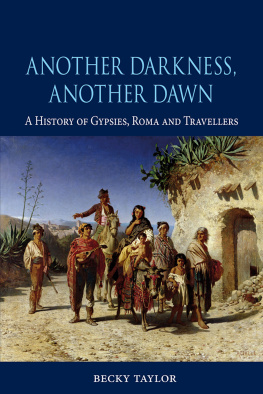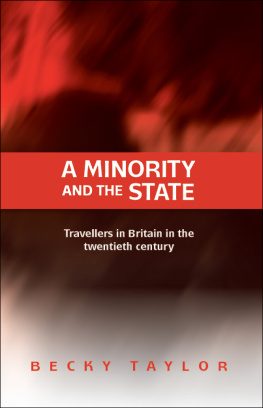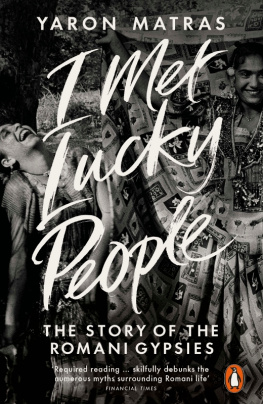ANOTHER DARKNESS,
ANOTHER DAWN

Another Darkness,
Another Dawn:
A History of Gypsies, Roma
and Travellers
Becky Taylor
REAKTION BOOKS
To my parents, for their love, so freely given
Published by Reaktion Books Ltd
33 Great Sutton Street
London EC1V 0DX, UK
www.reaktionbooks.co.uk
First published 2014
Copyright Becky Taylor 2014
All rights reserved
No part of this publication may be reproduced, stored in a retrieval system, or transmitted, in any form or by any means, electronic, mechanical, photocopying, recording or otherwise, without the prior permission of the publishers
Page references in the Photo Acknowledgements and
Index match the printed edition of this book.
Printed and bound in Great Britain
by TJ International, Padstow, Cornwall
A catalogue record for this book is available from the British Library
eISBN: 9781780232973
Contents
PREFACE
DESPITE THEIR PRESENCE across the world Gypsies, Roma and Travellers are some of the most marginalized and vilified people in society. They are rarely seen as having a place in a country, either geographically or socially, no matter where they live or what they do. Part of their marginalization stems from the fact that they are excluded from mainstream histories. At the same time, they are rarely granted a separate history, but rather seen to exist in a timeless bubble, unchanged and untouched by modern life. It remains that, despite a growing amount of research and writing, overall they are part of the historically inarticulate.
This book aims to serve not only as an introduction to the history of Romani peoples but crucially to show how their history is as intimately tied to the broader sweep of history as the rest of societys. Understanding their history is to take in the founding and contraction of empires, Reformation and Counter-Reformation, wars, the expansion of law and order and of states, the Enlightenment and the increasing regulation of the world: it is as much a history of ourselves as it is of others. In such a short volume it is not possible to cover all times and all places in the depth demanded by the subject. Instead, what I offer here is a way into understanding both the experiences of Romani peoples, and how settled societies have dealt with their presence. Inevitably this has meant focusing on some areas to the exclusion of others, but always with the aim of revealing the most significant trends and events affecting Gypsy history. The period to the end of the sixteenth century tracks movement across both place and time, taking in possible departures from north-west India, gradual migration to the Balkans and their reception across Europe in the early modern period. From this point onwards the amount of available evidence to historians increases significantly, allowing us to consider how they established themselves in Europe despite banishment and execution, as well as their arrival in the New World.

The main routes of Gypsies across Europe.
For the modern period, I have largely focused on the developments in four particular countries Britain, Germany, France and Bulgaria as a way of providing some focus and consistency to their history. These countries have been chosen as a way into exploring how different kinds of societies and states may have affected the reception, treatment and experiences of Romani peoples in modern times. Germanys experience of nationalism has had very different meanings and outcomes to that of the multi-ethnic Ottoman Empire from which Bulgaria sprang; while emerging ideas of citizenship and welfare played out differently in republican France, communist Bulgaria or in Britains relatively stable liberal democracy. In this way we can see how near universal stereotypes of Gypsies as marginal, criminal, deviant or romantic had diverse outcomes in different national contexts. Consequently this book acts as a springboard into thinking about the history of Gypsies while also opening up the question of how different societies saw themselves and the minorities in their midst. So, rather than implying that the experiences of Spanish, Polish, Scandinavian, American or indeed Argentinian Gypsies are any less worthy of study, I aim to provide a map that might be used by others to explore the countries beyond the scope of this volume.
Writing this book was a salutatory lesson in the dangers of believing in a progressive view of history: things dont always get better, especially if you belong to a marginalized ethnic group. But neither were they always necessarily as bad as they first appear. We will see how the institution of slavery for Gypsies coexisted under the Ottomans alongside remarkable cultural diversity and autonomy; how branding, mutilations and Gypsy hunts occurred at the same time that Gypsies established themselves across Europe; and how despite developments in education and attitudes towards minorities the modern world has failed to engender anything like acceptance of the place of Romani peoples within its societies. The lack of any simple, linear story of progress is illustrated in an examination of seventeenth-century executions of German Gypsies written in 1932. The writers outraged account was prefaced with the following observation:
It is, perhaps, a difficult matter for the modern mind, moulded by generations of increasing humanistic toleration, to imagine with sufficient realism some of the processes instrumental in the forming of our present European civilization. But here and there glimpses of the past are preserved, presenting vivid evidence of the manner in which Authority enforced Law and Order.
The irony of this observation, written at a time when the German National Socialists were poised to tighten anti-Roma and Sinti legislation to fatal effect across the Third Reich need not be laboured. More recently, attacks on Roma across the former Soviet bloc since 1989, the expulsion of Roma from Italy and France, as well as high-profile evictions of Irish Travellers from Dale Farm in the UK all serve to demonstrate how, centuries after their first arrival in Europe, Roma, Gypsies and Travellers remain unwelcome, with the legitimacy of their presence highly contested. This is no simple story of progression from brutal repression and marginalization in the early modern period, through attempts at assimilation and settlement in the nineteenth century to an inclusive and open world of early 21st-century multiculturalism.

Europe in the sixteenth century.
INTRODUCTION
In Search of the True Gypsy?
BEFORE I GO ANY FURTHER it is worth making plain that there is no one word that can cover the multitude of peoples who have been called, or might call themselves Roma, Gypsy or Traveller, or any of the national variations of these words over time and place. Recent work has confirmed exactly how problematic it is to label people known as Gypsies, with meanings often heavily contested and certainly not politically neutral. This is not simply a matter of semantics, since individuals and whole communities are still routinely deported, moved on or discriminated against on the grounds that they are, or are not, Gypsies/Roma/Travellers.











